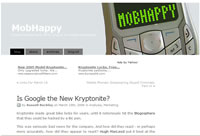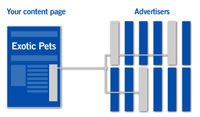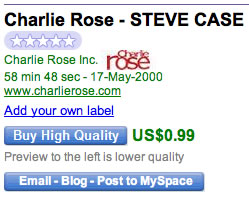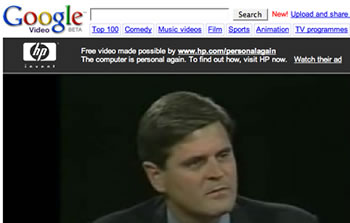 Suppose you ran a Web site, and got a little money in advertising. And then suppose someone came along, and said: “I can give you more readers, and extra advertising!” – would you be grateful? Especially if this was genuine, and tested out? Well, Russell Buckley isn’t grateful.
Suppose you ran a Web site, and got a little money in advertising. And then suppose someone came along, and said: “I can give you more readers, and extra advertising!” – would you be grateful? Especially if this was genuine, and tested out? Well, Russell Buckley isn’t grateful.
His moan sounds silly, but effectively, his gripe is that when Google Mobile take pages for his site and configure them for mobile phone surfers, they take out the adverts, and put their own adverts on. And he’s complained to Google about this, and blogged it, and still, they don’t respond.
He has, nonetheless, a point. His actual argument, when you strip away the egotism of comparing his complaint about Google with the collapse of Kryptonite business, is that Google is actually editing his page, not just formatting it.
 The Kryptonite comparison, summary: inhabitants of the InterWeb Blogland discovered you could steal a bike locked with Kryptonite even if all you had was a ball point pen, and Kryptonite dismissed those quaint Bloglanders as irrelevant. Well, yes; if you sell a product which is shown to be non-functional, you need to deal with the bad press.
The Kryptonite comparison, summary: inhabitants of the InterWeb Blogland discovered you could steal a bike locked with Kryptonite even if all you had was a ball point pen, and Kryptonite dismissed those quaint Bloglanders as irrelevant. Well, yes; if you sell a product which is shown to be non-functional, you need to deal with the bad press.
But the comparison viewed in one way is empty. Google is doing nothing of the sort – its product works, and works as described. It adds extra revenue to the Web site owner’s income stream, and it does it by making a sensible call on how to format pages.
Viewed from another position, you might think that Google should start of listen to the buzz on the blogs (it’s not like they don’t have the tool to find out is it!), in the way that Kryptonite _didn’t_.
That said, Google is arrogating to itself a decision which you’d normally expect the Web site manager to make: what appears on the Web page. And it really ought to have the consent of the site manager to do that. And if it hasn’t, then it should talk.
 Now, I can see Google’s point. “What is this guy’s problem?” you might say. After all, most adverts on Web pages are there without the explicit consent of the site manager. One-click and other advert providers post adverts “on the fly” and track the individual user. Click on one advert for fast cars, and they’ll probably show you more next time you visit; and they don’t ring up the Web site manager and ask specific permission. They just download the advert. (Eventually. When you’re almost out of patience, and thinking of switching to Firefox and running Adblock. Another story…)
Now, I can see Google’s point. “What is this guy’s problem?” you might say. After all, most adverts on Web pages are there without the explicit consent of the site manager. One-click and other advert providers post adverts “on the fly” and track the individual user. Click on one advert for fast cars, and they’ll probably show you more next time you visit; and they don’t ring up the Web site manager and ask specific permission. They just download the advert. (Eventually. When you’re almost out of patience, and thinking of switching to Firefox and running Adblock. Another story…)
What Google is doing is even more sensible. They are saying: “This advert is simply too big to run on a mobile phone. It will cost the phone owner real dosh to download, it won’t render properly, the advertiser will be horrified to see how it looks, and it will hide the actual page content which the subscriber wants to see. We’ll hide it, and show a Google Adsense advert instead.”
And frankly, most of us would say: “Exactly what we want you to do!” – and at the end of the day, the site owner gets a share of the Adsense revenue, from readers who wouldn’t have seen the page otherwise.
But if Russell told Google he didn’t want them to do that. He’s entitled to do so. And he blogged it when they ignored him. And yes, his blog got some traction – in that other bloggers linked to it – and Google still ignored him.
I get the impression his bona fides are not altogether clear, here, because someone who ought to know, has said that Russell has (or has had) an association with a rival outfit – Yahoo. It would be good to hear his response to that – but if true, it’s definitely something he should have disclosed. We’re pleased to say that Russell did get in touch, and we thank him for that. He assures us that he has no connections with Yahoo, and therefore has no axe to grind on this one.
At the end of the day, whatever the rights and wrongs of his approach, and whether he’s exaggerating the influence of his blog and the blogworld, or not, he has a point: Google is being arrogant. It is making decisions which its mobile clients have not asked for, and even, have specifically asked them not to do – and when they complain, it isn’t responding.
It may be small beer to Google, but it’s exactly this “faceless bureaucracy” which is its Achilles heel. Anybody who deals with the company will tell you that getting a real person to respond, is harder than getting a refund out of City Hall; and that the “don’t be evil” motto appears to be one which Google parses according to its own standards, not necessarily those of the rest of us.
 Sony and Sky are tying up to show the UK’s first HD advert tonight.
Sony and Sky are tying up to show the UK’s first HD advert tonight.  Shot over 10 days and with a crew of 250 people, the paint was mixed on site by 20 people. The clear up took 5 days and 60 people.
Shot over 10 days and with a crew of 250 people, the paint was mixed on site by 20 people. The clear up took 5 days and 60 people.  The launch of this first HD ad follows a major marketing agreement between Sky and Sony to promote HD.
The launch of this first HD ad follows a major marketing agreement between Sky and Sony to promote HD.  U.S. Internet advertising revenue has hit a new record high of nearly $8 billion for first six months of the year, increasing by a money-spinning 37 per cent, according to a new study.
U.S. Internet advertising revenue has hit a new record high of nearly $8 billion for first six months of the year, increasing by a money-spinning 37 per cent, according to a new study.  The IAB/ PricewaterhouseCoopers figures show that Internet advertising revenue totalled nearly $4.1 billion in the last quarter, representing a thumping a 36 percent increase over the same period last year, and up a healthy 5.5 percent over the first quarter of 2006.
The IAB/ PricewaterhouseCoopers figures show that Internet advertising revenue totalled nearly $4.1 billion in the last quarter, representing a thumping a 36 percent increase over the same period last year, and up a healthy 5.5 percent over the first quarter of 2006.  We’ve all known for years that PVR’s have been eating TV advertising. Murdoch has been on top of this for ages too, which makes it all the more interesting to hear that his Fox network is using 2-second Blinks, adverts.
We’ve all known for years that PVR’s have been eating TV advertising. Murdoch has been on top of this for ages too, which makes it all the more interesting to hear that his Fox network is using 2-second Blinks, adverts.  Overall, Clear Channel Radio has experienced mixed results following Less Is More, though recent quarters have shown positive revenue increases. Clear Channel executives have credited those jumps to the shortened advertising slots, which address a major source of radio listener irritation.
Overall, Clear Channel Radio has experienced mixed results following Less Is More, though recent quarters have shown positive revenue increases. Clear Channel executives have credited those jumps to the shortened advertising slots, which address a major source of radio listener irritation.  Viacom have been making further moves to secure their future in digital media. Given all of the moves they’ve made this week, we thought it was worth summarising it.
Viacom have been making further moves to secure their future in digital media. Given all of the moves they’ve made this week, we thought it was worth summarising it.  Viacom are experts at delivering messages (TV, films and adverts to you and me) on television and films, and as we can see from the above deals, they’ve caught on that they really ought to be able to do this online too. To try and simplify this, they were looking for a way to smooth the transition of their content to the digital realm.
Viacom are experts at delivering messages (TV, films and adverts to you and me) on television and films, and as we can see from the above deals, they’ve caught on that they really ought to be able to do this online too. To try and simplify this, they were looking for a way to smooth the transition of their content to the digital realm.  Google Video has been serving videos to the Internet population for over a year and a half now, both
Google Video has been serving videos to the Internet population for over a year and a half now, both  Clicking on Watch their Ad link opens a new browser session and plays the video advert from … Google Video. All very neat.
Clicking on Watch their Ad link opens a new browser session and plays the video advert from … Google Video. All very neat.  PayPal is to be the exclusive online wallet across Yahoo’s product and services. In a wide-ranging, four component, business arrangement announced today, eBay and Yahoo will be stroking each other commercial departments.
PayPal is to be the exclusive online wallet across Yahoo’s product and services. In a wide-ranging, four component, business arrangement announced today, eBay and Yahoo will be stroking each other commercial departments.  Interestingly Yahoo will also be offering sponsored search for complementary products on some eBay.com search results pages in the U.S.
Interestingly Yahoo will also be offering sponsored search for complementary products on some eBay.com search results pages in the U.S.  For us, this part of the announcement is a bit of a strange one. Yahoo has Yahoo Messenger with Voice and eBay has Skype, so who would provide the voice services in which circumstances is pretty unclear, and we would have though, an area for friction.
For us, this part of the announcement is a bit of a strange one. Yahoo has Yahoo Messenger with Voice and eBay has Skype, so who would provide the voice services in which circumstances is pretty unclear, and we would have though, an area for friction.  Broadband giants Telewest have had to bend over and feel the sharp swish of the Advertising Standards Agency’s corrective ruler on their ample rumps after their broadband radio advert was deemed ‘misleading.’
Broadband giants Telewest have had to bend over and feel the sharp swish of the Advertising Standards Agency’s corrective ruler on their ample rumps after their broadband radio advert was deemed ‘misleading.’  A Telewest customer – clearly already living in a Telewest area – liked the sound of the deal so much they rang up to sign on, only to find that they were clearly in the wrong sort of ‘Telewest area.’
A Telewest customer – clearly already living in a Telewest area – liked the sound of the deal so much they rang up to sign on, only to find that they were clearly in the wrong sort of ‘Telewest area.’  The ASA concluded, “We considered this important restriction should have been explained in the ad and that “Conditions apply” had not been adequate to cover such a significant condition to the offer. The ad breached CAP (Broadcast) Radio Advertising Standards Code section 2, rule 3.”
The ASA concluded, “We considered this important restriction should have been explained in the ad and that “Conditions apply” had not been adequate to cover such a significant condition to the offer. The ad breached CAP (Broadcast) Radio Advertising Standards Code section 2, rule 3.”  Companies are now starting to dip their toe into the world of Mashups/user-generated content – but when the user is generating it, the results might not always be what they expect or desire. We’ve seen a few examples of this today.
Companies are now starting to dip their toe into the world of Mashups/user-generated content – but when the user is generating it, the results might not always be what they expect or desire. We’ve seen a few examples of this today.  Amazingly the thing that they don’t appear to have noticed is that many people see Chevy as Uber in a couple of sense – the sheer size of their company and, importantly for this piece, in the sheer size of the cars on the road and fuel-guzzling nature.
Amazingly the thing that they don’t appear to have noticed is that many people see Chevy as Uber in a couple of sense – the sheer size of their company and, importantly for this piece, in the sheer size of the cars on the road and fuel-guzzling nature.  We love the idea of corporate tools being used against those who are paying for they development, hosting and bandwidth, but suspect that corporate number two who approaches this may take a different approach. This won’t of course stop those who are angered by this type of thing using their own footage to the same affect.
We love the idea of corporate tools being used against those who are paying for they development, hosting and bandwidth, but suspect that corporate number two who approaches this may take a different approach. This won’t of course stop those who are angered by this type of thing using their own footage to the same affect.  Suppose you ran a Web site, and got a little money in advertising. And then suppose someone came along, and said: “I can give you more readers, and extra advertising!” – would you be grateful? Especially if this was genuine, and tested out? Well,
Suppose you ran a Web site, and got a little money in advertising. And then suppose someone came along, and said: “I can give you more readers, and extra advertising!” – would you be grateful? Especially if this was genuine, and tested out? Well,  The Kryptonite comparison, summary: inhabitants of the InterWeb Blogland discovered you could steal a bike locked with Kryptonite even if all you had was a ball point pen, and Kryptonite dismissed those quaint Bloglanders as irrelevant. Well, yes; if you sell a product which is shown to be non-functional, you need to deal with the bad press.
The Kryptonite comparison, summary: inhabitants of the InterWeb Blogland discovered you could steal a bike locked with Kryptonite even if all you had was a ball point pen, and Kryptonite dismissed those quaint Bloglanders as irrelevant. Well, yes; if you sell a product which is shown to be non-functional, you need to deal with the bad press.  Now, I can see Google’s point. “What is this guy’s problem?” you might say. After all, most adverts on Web pages are there without the explicit consent of the site manager. One-click and other advert providers post adverts “on the fly” and track the individual user. Click on one advert for fast cars, and they’ll probably show you more next time you visit; and they don’t ring up the Web site manager and ask specific permission. They just download the advert. (Eventually. When you’re almost out of patience, and thinking of switching to Firefox and running Adblock. Another story…)
Now, I can see Google’s point. “What is this guy’s problem?” you might say. After all, most adverts on Web pages are there without the explicit consent of the site manager. One-click and other advert providers post adverts “on the fly” and track the individual user. Click on one advert for fast cars, and they’ll probably show you more next time you visit; and they don’t ring up the Web site manager and ask specific permission. They just download the advert. (Eventually. When you’re almost out of patience, and thinking of switching to Firefox and running Adblock. Another story…)  Making blogging too easy seems to be making it hard. It may be coincidence, but one example of “too easy” blogging is the spam blog, or splog – and suddenly, there’s a rash of upset bloggers who have had their blogs blacked.
Making blogging too easy seems to be making it hard. It may be coincidence, but one example of “too easy” blogging is the spam blog, or splog – and suddenly, there’s a rash of upset bloggers who have had their blogs blacked.  And a spam blog is something that doesn’t actually have any real content. It’s just links to trackback pointers for everybody else. The trouble is, all the signs of a spam blog are caused by the ease with which they are built. You just have to create the blog (two clicks) and then set up a robot that scours the web for new posts, and links to the trackbacks.
And a spam blog is something that doesn’t actually have any real content. It’s just links to trackback pointers for everybody else. The trouble is, all the signs of a spam blog are caused by the ease with which they are built. You just have to create the blog (two clicks) and then set up a robot that scours the web for new posts, and links to the trackbacks.  I’m not saying that Qumana is what caused the blog to be blacked. I am saying that if it produces a series of random, unrelated tags to a single site, it’s going to fulfil one of the prime indicators of a splog. And when random, unrelated blog entries all get tagged “Qumana” whatever their subject, you have something so similar, it’s going to be quite hard to see what a blog provider can do to filter it.
I’m not saying that Qumana is what caused the blog to be blacked. I am saying that if it produces a series of random, unrelated tags to a single site, it’s going to fulfil one of the prime indicators of a splog. And when random, unrelated blog entries all get tagged “Qumana” whatever their subject, you have something so similar, it’s going to be quite hard to see what a blog provider can do to filter it.